Shrimp Pad Thai for Two
By Thom7747
This version of pad thai, developed by cookbook author and teacher Nancie McDermott, is for those who may not have a wok at home. Although in Thailand pad thai is a street-vendor specialty, stir-fried in single portions right in front of you, McDermott knows that vendor-style won't fly with American home cooks. In this recipe, she's devised a way to produce a superb pad thai in a 12-inch heavy skillet, but be aware that the skillet can hold only enough ingredients for two people (of course, if you have a wok, you should use it). McDermott's pad thai recipe to serve four , which does require a wok, is reason enough to invest in one (they are inexpensive and last forever; look for a 14-inch flat-bottom carbon-steel wok). In either case you will be rewarded with the most authentic pad thai possible with ingredients from the supermarket. If the length of the recipe looks daunting, rest assured it comes together quickly; we included important tips within the procedure to make the process as foolproof as possible.
Ingredients
- SEASONING SAUCE:
- 3 tablespoons water
- 2 teaspoons prepared tamarind paste, preferably unsweetened, such as Neera's or Rani brands*
- 3 tablespoons palm sugar or packed dark brown sugar
- 3 tablespoons Asian fish sauce (also called nam pla or nuoc mam)
- 1/8 teaspoon salt
- FOR SERVING:
- 3 ounces (about 1 cup) fresh mung bean sprouts
- 2 limes, cut into wedges
- 3 tablespoons salted dry-roasted peanuts, coarsely chopped
- 1/4 cup Asian fish sauce (also called nam pla or nuoc mam)
- 1/4 cup granulated sugar
- 1/4 cup crushed red pepper
- RICE NOODLES:
- Boiling water for soaking noodles
- 6 ounces dried flat rice noodles (slender, linguine-width; sometimes called Pad Thai noodles or stir-fry rice noodles)
- FOR STIR-FRYING THE NOODLES:
- 1 tablespoon garlic, chopped, about 2 large cloves
- 1 tablespoon shallot or onion, chopped
- 6 ounces small or medium shrimp, peeled, deveined and patted dry
- 2 large eggs, beaten well
- 3 ounces fresh mung bean sprouts, about 1 cup
- 1 bunch scallions, greens only, cut into 1-inch pieces, about 1/2 cup
- 1/3 cup salted dry-roasted peanuts, coarsely chopped
- 3 tablespoons vegetable oil
Details
Servings 2
Preparation time 35mins
Cooking time 35mins
Adapted from epicurious.com
Preparation
Step 1
SEASONING SAUCE:
In a medium bowl, combine the water, tamarind paste, palm or dark brown sugar, fish sauce, and salt and stir until the sugar is dissolved.
ASSEMBLE INGREDIENTS FOR SERVING:
Place the bean sprouts, limes, and peanuts each in their own small bowl and arrange near the stove. Place the fish sauce, granulated sugar, and crushed red pepper each in their own small bowl and arrange on the dining table.
SOFTEN RICE NOODLES:
Bring a 3-quart saucepan of water to a full, rolling boil. Remove it from the heat and immediately add the rice noodles, making sure they are fully submerged in the water. Let the noodles soak for exactly 3 minutes (use a timer), occasionally lifting them up and pulling them apart as necessary with tongs or a long fork to keep the noodles separate and help them soften evenly. Drain the noodles in a large colander and rinse them under cold running water. (If the noodles become sticky and clumped together while standing, rinse them briefly under cold water just before cooking, so that they return to their slippery, firm, toss-able state.)
STIR-FRY THE PAD THAI:
In a small bowl, combine the garlic and shallot. Place the shrimp, beaten eggs, bean sprouts, scallion greens, and peanuts each in their own bowl and arrange near the stove. Have ready 1 clean medium bowl for the cooked shrimp and eggs, and arrange a large plate or platter for serving near the stove.
Heat a 12-inch heavy, deep skillet or sauté pan or a large wok over high heat until hot but not smoking. (If at any point during cooking the oil starts smoking, lower the heat.) Add 1 tablespoon of the vegetable oil and swirl to coat the pan. When the oil is hot, scatter in the shrimp. Cook undisturbed until the shrimp begin to change color and firm up, about 30 seconds. Toss well then continue to cook, stirring frequently, until the shrimp are pink, firm, and just cooked through, about 30 seconds longer. Using a slotted spoon, transfer the shrimp to the clean bowl.
Add the eggs and swirl the pan to spread them into a thin layer. Cook the eggs, lifting the sides and tilting the pan to allow the uncooked eggs to pour underneath as you would do with an omelet, until the eggs are mostly set, about 1 minute. Remove the pan from the heat and use the slotted spoon to quickly cut the eggs into bite-size pieces, then add them to the bowl of shrimp.
Place the pan over high heat and add the remaining 2 tablespoons of the vegetable oil, swirling the pan to coat it evenly (if at any point during cooking the oil starts smoking, lower the heat). Add the garlic and shallot and stir-fry until fragrant, about 5 seconds. Scatter in the softened rice noodles, and, using tongs, evenly spread the noodles out across the pan, like a net. Let them cook undisturbed for 15 seconds then scoop them in toward the center. Toss the noodles gently then spread them out again. Pour about 1/3 of the seasoning sauce around the edges of the pan, and continue stir-frying the noodles in the same manner, spreading them out and letting them cook undisturbed occasionally, until most of the sauce is absorbed, about 30 seconds more.
Add another third of the sauce and continue to stir-fry in the same manner until most of the sauce is absorbed and the noodles are just tender but not mushy, about 30 seconds. Test a noodle or two: If they are too firm, add about 2 tablespoons of water around the edge of the pan, and continue stir-frying until they are just tender and evenly coated with the sauce.
Return the shrimp and eggs to the pan, along with any juices collected in the bottom of the bowl, and toss to incorporate them into the noodles. Add the remaining third of the seasoning sauce, along with the bean sprouts, scallion greens, and chopped peanuts, and cook, tossing, until they are mixed in and barely heated, about 30 seconds.
TO SERVE:
Quickly transfer the noodles to the platter, mounding them at one end. Mound the reserved bean sprouts next to the noodles, and arrange the reserved lime wedges next to the bean sprouts. Sprinkle the peanuts on the noodles in a stripe next to the bean sprouts. Serve hot, passing the small bowls of fish sauce, sugar, and crushed red pepper so that guests can flavor their portions to taste.
NOTE:
Tamarind paste tends to be a South Asian product; it usually comes in a jar and is available in many supermarkets. Its smooth texture makes it easier and faster to use than the traditional Thai blocks of tamarind pulp that include the fruit's seeds and fibers. Read the label carefully to see if the tamarind paste is sweetened or not; if the jar you purchase contains a sweetener, just use less sugar in your seasoning sauce.
You'll also love
-
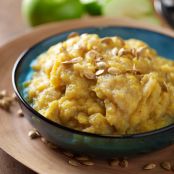 Mashed Acorn Squash with Apples
4.3/5
(8 Votes)
Mashed Acorn Squash with Apples
4.3/5
(8 Votes)
-
 Cherry Pie Cookies
4.7/5
(6 Votes)
Cherry Pie Cookies
4.7/5
(6 Votes)
-
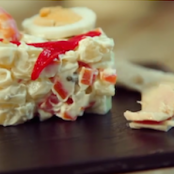 Russian Salad with Isabel Tuna
4.7/5
(7 Votes)
Russian Salad with Isabel Tuna
4.7/5
(7 Votes)
-
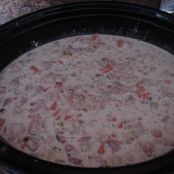 BEEFMAN BEST MANHATTON CLAM CHOWDER
4.7/5
(6 Votes)
BEEFMAN BEST MANHATTON CLAM CHOWDER
4.7/5
(6 Votes)
-
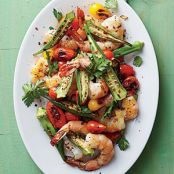 Skillet-Roasted Okra and Shrimp
4.7/5
(6 Votes)
Skillet-Roasted Okra and Shrimp
4.7/5
(6 Votes)
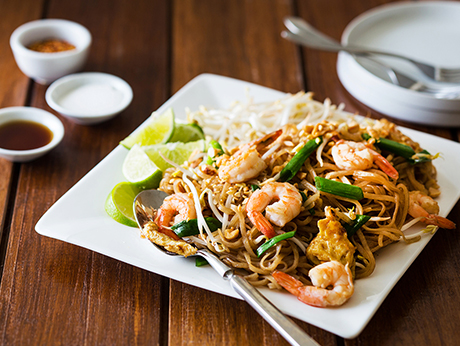
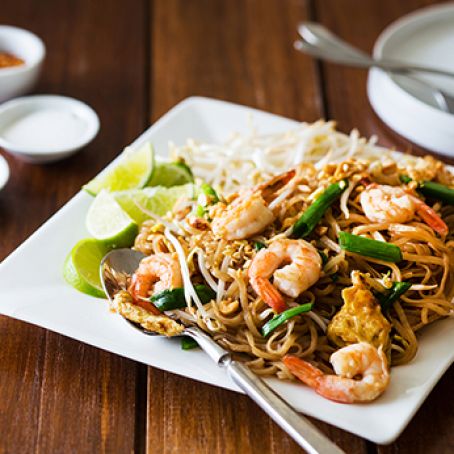
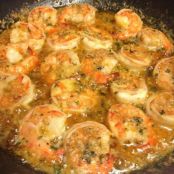
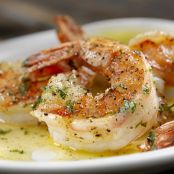
Review this recipe